Outsourcing
- 格式:pdf
- 大小:314.50 KB
- 文档页数:18
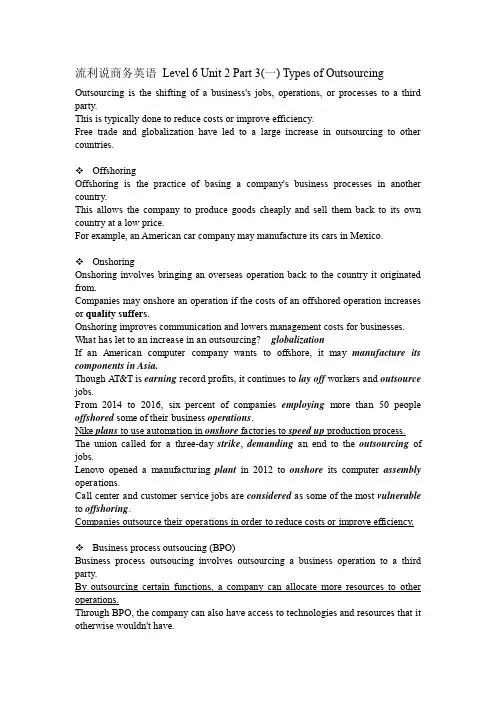
流利说商务英语Level 6 Unit 2 Part 3(一) Types of Outsourcing Outsourcing is the shifting of a business's jobs, operations, or processes to a third party.This is typically done to reduce costs or improve efficiency.Free trade and globalization have led to a large increase in outsourcing to other countries.OffshoringOffshoring is the practice of basing a company's business processes in another country.This allows the company to produce goods cheaply and sell them back to its own country at a low price.For example, an American car company may manufacture its cars in Mexico.OnshoringOnshoring involves bringing an overseas operation back to the country it originated from.Companies may onshore an operation if the costs of an offshored operation increases or quality suffers.Onshoring improves communication and lowers management costs for businesses. What has let to an increase in an outsourcing? globalizationIf an American computer company wants to offshore, it may manufacture its components in Asia.Though AT&T is earning record profits, it continues to lay off workers and outsource jobs.From 2014 to 2016, six percent of companies employing more than 50 people offshored some of their business operations.Nike plans to use automation in onshore factories to speed up production process. The union called for a three-day strike, demanding an end to the outsourcing of jobs.Lenovo opened a manufacturing plant in 2012 to onshore its computer assembly operations.Call center and customer service jobs are considered as some of the most vulnerable to offshoring.Companies outsource their operations in order to reduce costs or improve efficiency. Business process outsoucing (BPO)Business process outsoucing involves outsourcing a business operation to a third party.By outsourcing certain functions, a company can allocate more resources to other operations.Through BPO, the company can also have access to technologies and resources that it otherwise wouldn't have.Information technology outsourcing (ITO)Companies can use IT outsourcing for network infrastructure, software development, and maintenance.To save money, a company may outsource its IT management by using a third party rather than its own IT team.However, ITO can put a company at risk since it may allow a third party to access the company's sensitive data.Knowledge Process Outsourcing (KPO)Knowledge processing is the process of creating and spreading information.KPO provides expert-level knowledge and analysis on complicated fields, such as legal services and market research.Industries such as R&D, business analysis, and financial consultancy may outsource positions to find knowledgeable, qualified experts.The outsourcing of a business operation to a third party is called business process outsourcing.What is a risk letting a third party handle sensitive data?The data security may be compromised.An example of KPO services includes consulting.Bringing an overseas operation back to the country it originated from onshoring Global figures show that by the end of 2017, 31% of all IT services were outsourced. The Philippines has established itself in the global KPO market as the leading destination.。

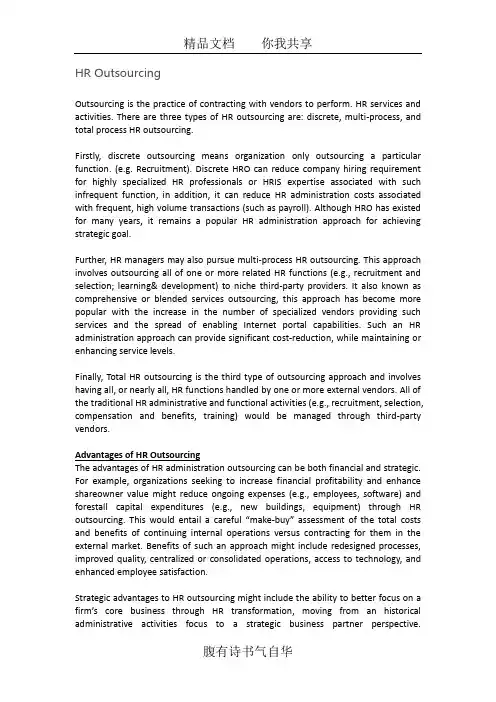
HR OutsourcingOutsourcing is the practice of contracting with vendors to perform. HR services and activities. There are three types of HR outsourcing are: discrete, multi-process, and total process HR outsourcing.Firstly, discrete outsourcing means organization only outsourcing a particular function. (e.g. Recruitment). Discrete HRO can reduce company hiring requirement for highly specialized HR professionals or HRIS expertise associated with such infrequent function, in addition, it can reduce HR administration costs associated with frequent, high volume transactions (such as payroll). Although HRO has existed for many years, it remains a popular HR administration approach for achieving strategic goal.Further, HR managers may also pursue multi-process HR outsourcing. This approach involves outsourcing all of one or more related HR functions (e.g., recruitment and selection; learning& development) to niche third-party providers. It also known as comprehensive or blended services outsourcing, this approach has become more popular with the increase in the number of specialized vendors providing such services and the spread of enabling Internet portal capabilities. Such an HR administration approach can provide significant cost-reduction, while maintaining or enhancing service levels.Finally, Total HR outsourcing is the third type of outsourcing approach and involves having all, or nearly all, HR functions handled by one or more external vendors. All of the traditional HR administrative and functional activities (e.g., recruitment, selection, compensation and benefits, training) would be managed through third-party vendors.Advantages of HR OutsourcingThe advantages of HR administration outsourcing can be both financial and strategic. For example, organizations seeking to increase financial profitability and enhance shareowner value might reduce ongoing expenses (e.g., employees, software) and forestall capital expenditures (e.g., new buildings, equipment) through HR outsourcing. This would entail a careful “make-buy” assessment of the total costs and benefits of continuing internal operations versus contracting for them in the external market. Benefits of such an approach might include redesigned processes, improved quality, centralized or consolidated operations, access to technology, and enhanced employee satisfaction.Strategic advantages to HR outsourcing might include the ability to better focus on a firm’s core business through HR transformation, moving from an historical administrative activities focus to a strategic business partner perspective.Organizations recognize that, more than ever, effective talent management may be the source of sustainable strategic advantage in a knowledge-based, global economy. However, many HR professionals are mired in day-to-day administrative tasks that preclude the value-added consulting, planning, and visioning activities required from them to achieve strategic goals. HR outsourcing could free HR professionals to focus on strategic issues (e.g., talent management, merger and acquisition due-diligence) while providing the firm with skilled professionals services in HR functional (e.g., recruitment, compensation) and administrative (e.g., government compliance and regulations) areas, powered by up-to-date technology (e.g., hardware, software). Disadvantages of HR Outsourcing.Although there are a number of financial and strategic reasons for considering HR administration outsourcing, there are also serious potential problems for firms who use the approach without fully understanding how to manage it to achieve desired goals. For example, firms who used HRO to achieve HR transformation and cost savings rated their success an average of 3 on a 5-point (1 = benefits not at all achieved and 5 = benefits fully achieved) scale. Thus, one big disadvantage of HRO is the likelihood that the organization will not achieve its strategic goals. Such a failure could have significant, negative impact on the organization’s ability to survive. Steps to minimize such a failure include realistic cost-benefit analyses, successful project planning and implementation, unambiguous goals and measures of HR outsourcing success, rigorous vendor assessment and selection processes, and skilled vendor contract negotiation, management, and auditing. Indeed, one of the primary responsibilities of HR administration managers in an outsourcing environment is to ensure that the contract terms and fulfilled on a daily basis and that corrective actions are immediately taken when failures occur.Another disadvantage of HR outsourcing includes the loss of institutional expertise in the outsourced functions, making an HR outsourcing decision reversal difficult or impossible. Frequently, when outsourcing is undertaken, subject matter experts (e.g., selection) are reassigned or released. This can be a serious strategic error if the vendor is unable to fulfill its contractual obligations. As noted above, an organization would be unwise to outsource core or strategic HR planning functions because of the possibility that competitors may learn its plans from vendors. In addition, loss of internal strategic HR expertise may be devastating to an organization over time. Moreover, HR organizations may lack the contract management expertise to oversee the vendor and hold it accountable for contract terms, compounding its problems. Other potential problems include security risks in multi-vendor outsourcing, internal employee and manager resistance, compliance failures (e.g., Sarbanes-Oxley), and cultural clashes between the organization and its vendors.In summary, HR outsourcing is another approach to HR administration that offers potential for cost reduction, process improvement, and employee satisfaction. However, managers of HR administrative functions must be highly skilled at usingHRO strategically to achieve organizational goals.出师表两汉:诸葛亮先帝创业未半而中道崩殂,今天下三分,益州疲弊,此诚危急存亡之秋也。

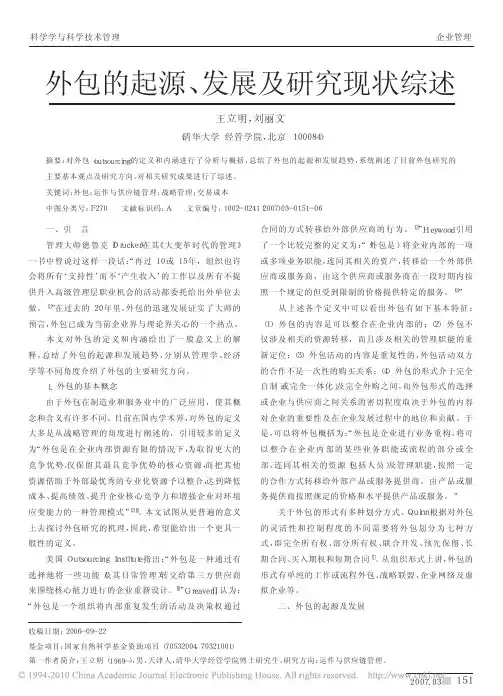
一、引言管理大师德鲁克(Drucker)在其《大变革时代的管理》一书中曾说过这样一段话:“再过10或15年,组织也许会将所有‘支持性’而不‘产生收入’的工作以及所有不提供升入高级管理层职业机会的活动都委托给出外单位去做。
[1]”在过去的20年里,外包的迅速发展证实了大师的预言,外包已成为当前企业界与理论界关心的一个热点。
本文对外包的定义和内涵给出了一般意义上的解释,总结了外包的起源和发展趋势,分别从管理学、经济学等不同角度介绍了外包的主要研究方向。
1.外包的基本概念由于外包在制造业和服务业中的广泛应用,使其概念和含义有许多不同。
目前在国内学术界,对外包的定义大多是从战略管理的角度进行阐述的,引用较多的定义为“外包是在企业内部资源有限的情况下,为取得更大的竞争优势,仅保留其最具竞争优势的核心资源,而把其他资源借助于外部最优秀的专业化资源予以整合,达到降低成本、提高绩效、提升企业核心竞争力和增强企业对环境应变能力的一种管理模式”[2][3]。
本文试图从更普遍的意义上去探讨外包研究的机理,因此,希望能给出一个更具一般性的定义。
美国OutsourcingInstitute指出:“外包是一种通过有选择地将一些功能(及其日常管理)转交给第三方供应商来围绕核心能力进行的企业重新设计。
[4]”GreaverⅡ认为:“外包是一个组织将内部重复发生的活动及决策权通过合同的方式转移给外部供应商的行为。
[5]”Heywood引用了一个比较完整的定义为:“(外包是)将企业内部的一项或多项业务职能,连同其相关的资产,转移给一个外部供应商或服务商,由这个供应商或服务商在一段时期内按照一个规定的但受到限制的价格提供特定的服务。
[6]”从上述各个定义中可以看出外包有如下基本特征:(1)外包的内容是可以整合在企业内部的;(2)外包不仅涉及相关的资源转移,而且涉及相关的管理职能的重新定位;(3)外包活动的内容是重复性的,外包活动双方的合作不是一次性的购买关系;(4)外包的形式介于完全自制(或完全一体化)及完全外购之间,而外包形式的选择或企业与供应商之间关系的密切程度取决于外包的内容对企业的重要性及在企业发展过程中的地位和贡献。
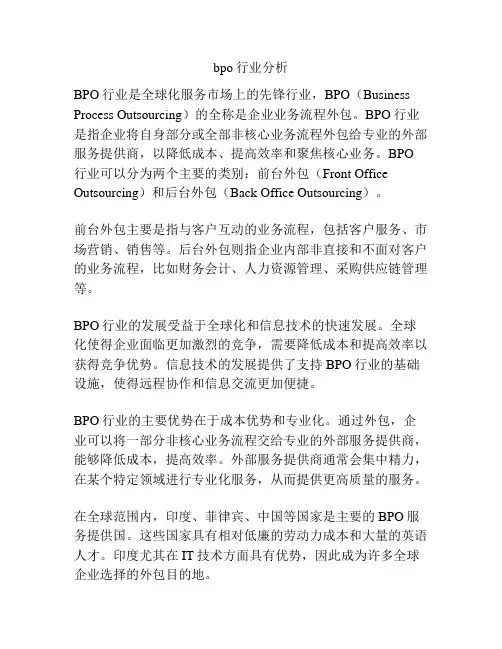
bpo行业分析BPO行业是全球化服务市场上的先锋行业,BPO(Business Process Outsourcing)的全称是企业业务流程外包。
BPO行业是指企业将自身部分或全部非核心业务流程外包给专业的外部服务提供商,以降低成本、提高效率和聚焦核心业务。
BPO 行业可以分为两个主要的类别:前台外包(Front Office Outsourcing)和后台外包(Back Office Outsourcing)。
前台外包主要是指与客户互动的业务流程,包括客户服务、市场营销、销售等。
后台外包则指企业内部非直接和不面对客户的业务流程,比如财务会计、人力资源管理、采购供应链管理等。
BPO行业的发展受益于全球化和信息技术的快速发展。
全球化使得企业面临更加激烈的竞争,需要降低成本和提高效率以获得竞争优势。
信息技术的发展提供了支持BPO行业的基础设施,使得远程协作和信息交流更加便捷。
BPO行业的主要优势在于成本优势和专业化。
通过外包,企业可以将一部分非核心业务流程交给专业的外部服务提供商,能够降低成本,提高效率。
外部服务提供商通常会集中精力,在某个特定领域进行专业化服务,从而提供更高质量的服务。
在全球范围内,印度、菲律宾、中国等国家是主要的BPO服务提供国。
这些国家具有相对低廉的劳动力成本和大量的英语人才。
印度尤其在IT技术方面具有优势,因此成为许多全球企业选择的外包目的地。
然而,BPO行业也面临一些挑战。
首先是安全和隐私问题。
企业外包业务流程需要考虑数据的安全性和保密性,确保外部服务提供商能够妥善处理客户的敏感信息。
其次是跨文化管理问题。
由于BPO行业通常涉及全球化服务,企业需要面对不同文化和价值观的差异,这就需要跨文化管理能力。
第三是服务质量问题。
虽然外包可以提高效率和专业化程度,但有时候外部服务提供商的服务质量可能无法达到企业的预期,这就需要企业与外部服务提供商进行有效合作和管理。
总之,BPO行业作为全球化服务市场上的先锋行业,为企业提供了降低成本、提高效率和聚焦核心业务的机会。
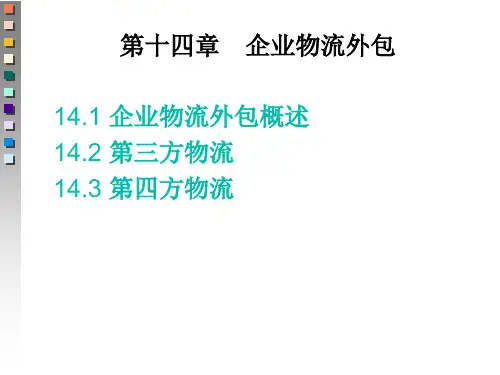
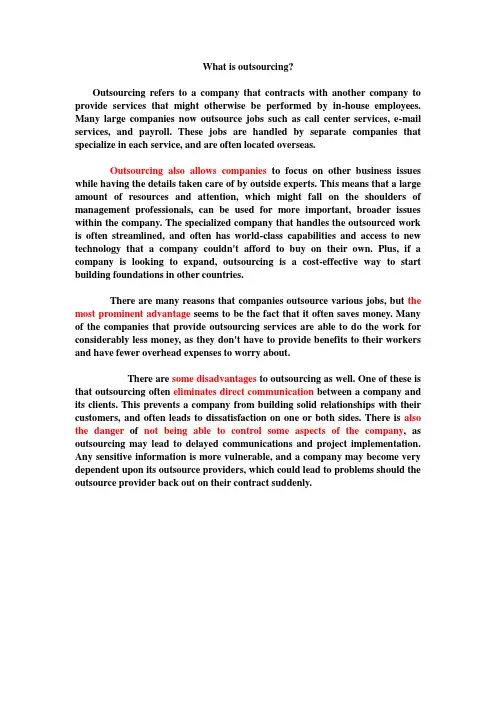
What is outsourcing?Outsourcing refers to a company that contracts with another company to provide services that might otherwise be performed by in-house employees. Many large companies now outsource jobs such as call center services, e-mail services, and payroll. These jobs are handled by separate companies that specialize in each service, and are often located overseas.Outsourcing also allows companies to focus on other business issues while having the details taken care of by outside experts. This means that a large amount of resources and attention, which might fall on the shoulders of management professionals, can be used for more important, broader issues within the company. The specialized company that handles the outsourced work is often streamlined, and often has world-class capabilities and access to new technology that a company couldn't afford to buy on their own. Plus, if a company is looking to expand, outsourcing is a cost-effective way to start building foundations in other countries.There are many reasons that companies outsource various jobs, but the most prominent advantage seems to be the fact that it often saves money. Many of the companies that provide outsourcing services are able to do the work for considerably less money, as they don't have to provide benefits to their workers and have fewer overhead expenses to worry about.There are some disadvantages to outsourcing as well. One of these is that outsourcing often eliminates direct communication between a company and its clients. This prevents a company from building solid relationships with their customers, and often leads to dissatisfaction on one or both sides. There is also the danger of not being able to control some aspects of the company, as outsourcing may lead to delayed communications and project implementation. Any sensitive information is more vulnerable, and a company may become very dependent upon its outsource providers, which could lead to problems should the outsource provider back out on their contract suddenly.。
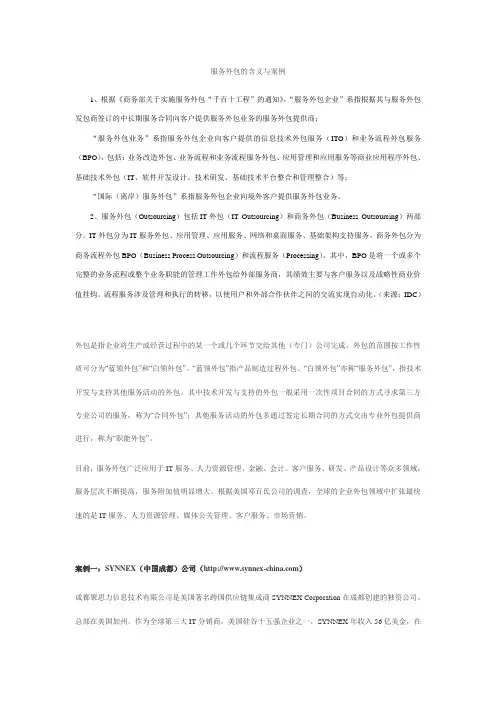
服务外包的含义与案例1、根据《商务部关于实施服务外包“千百十工程”的通知》,“服务外包企业”系指根据其与服务外包发包商签订的中长期服务合同向客户提供服务外包业务的服务外包提供商;“服务外包业务”系指服务外包企业向客户提供的信息技术外包服务(ITO)和业务流程外包服务(BPO),包括:业务改造外包、业务流程和业务流程服务外包、应用管理和应用服务等商业应用程序外包、基础技术外包(IT、软件开发设计、技术研发、基础技术平台整合和管理整合)等;“国际(离岸)服务外包”系指服务外包企业向境外客户提供服务外包业务。
2、服务外包(Outsourcing)包括IT外包(IT Outsourcing)和商务外包(Business Outsourcing)两部分。
IT外包分为IT服务外包、应用管理、应用服务、网络和桌面服务、基础架构支持服务。
商务外包分为商务流程外包BPO(Business Process Outsourcing)和流程服务(Processing)。
其中,BPO是将一个或多个完整的业务流程或整个业务职能的管理工作外包给外部服务商,其绩效主要与客户服务以及战略性商业价值挂钩。
流程服务涉及管理和执行的转移,以使用户和外部合作伙伴之间的交流实现自动化。
(来源:IDC)外包是指企业将生产或经营过程中的某一个或几个环节交给其他(专门)公司完成。
外包的范围按工作性质可分为―蓝领外包‖和―白领外包‖。
―蓝领外包‖指产品制造过程外包。
―白领外包‖亦称―服务外包‖,指技术开发与支持其他服务活动的外包。
其中技术开发与支持的外包一般采用一次性项目合同的方式寻求第三方专业公司的服务,称为―合同外包‖;其他服务活动的外包多通过签定长期合同的方式交由专业外包提供商进行,称为―职能外包‖。
目前,服务外包广泛应用于IT服务、人力资源管理、金融、会计、客户服务、研发、产品设计等众多领域,服务层次不断提高,服务附加值明显增大。
根据美国邓百氏公司的调查,全球的企业外包领域中扩张最快速的是IT服务、人力资源管理、媒体公关管理、客户服务、市场营销。
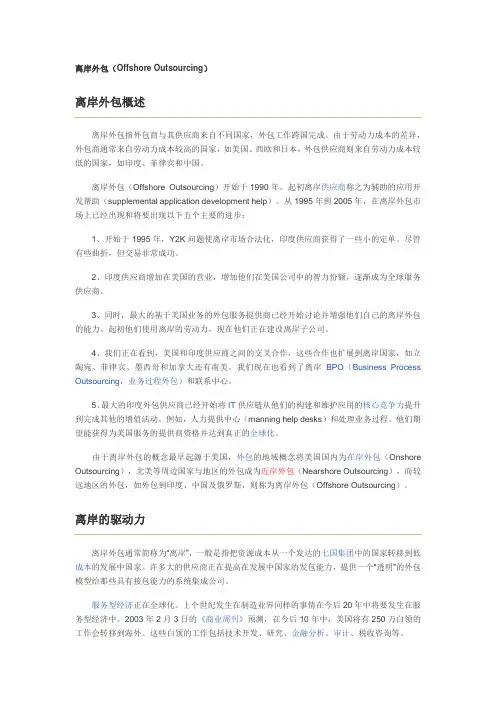
离岸外包(Offshore Outsourcing)离岸外包概述离岸外包指外包商与其供应商来自不同国家,外包工作跨国完成。
由于劳动力成本的差异,外包商通常来自劳动力成本较高的国家,如美国、西欧和日本,外包供应商则来自劳动力成本较低的国家,如印度、菲律宾和中国。
离岸外包(Offshore Outsourcing)开始于1990年。
起初离岸供应商称之为辅助的应用开发帮助(supplemental application development help)。
从1995年到2005年,在离岸外包市场上已经出现和将要出现以下五个主要的进步:1、开始于1995年,Y2K问题使离岸市场合法化,印度供应商获得了一些小的定单。
尽管有些曲折,但交易非常成功。
2、印度供应商增加在美国的营业,增加他们在美国公司中的智力份额,逐渐成为全球服务供应商。
3、同时,最大的基于美国业务的外包服务提供商已经开始讨论并增强他们自己的离岸外包的能力。
起初他们使用离岸的劳动力,现在他们正在建设离岸子公司。
4、我们正在看到,美国和印度供应商之间的交叉合作,这些合作也扩展到离岸国家,如立陶宛、菲律宾、墨西哥和加拿大还有南美。
我们现在也看到了离岸BPO(Business Process Outsourcing,业务过程外包)和联系中心。
5、最大的印度外包供应商已经开始将IT供应链从他们的构建和维护应用的核心竞争力提升到完成其他的增值活动,例如,人力提供中心(manning help desks)和处理业务过程。
他们期望能获得为美国服务的提供商资格并达到真正的全球化。
由于离岸外包的概念最早起源于美国,外包的地域概念将美国国内为在岸外包(Onshore Outsourcing),北美等周边国家与地区的外包成为近岸外包(Nearshore Outsourcing),而较远地区的外包,如外包到印度、中国及俄罗斯,则称为离岸外包(Offshore Outsourcing)。
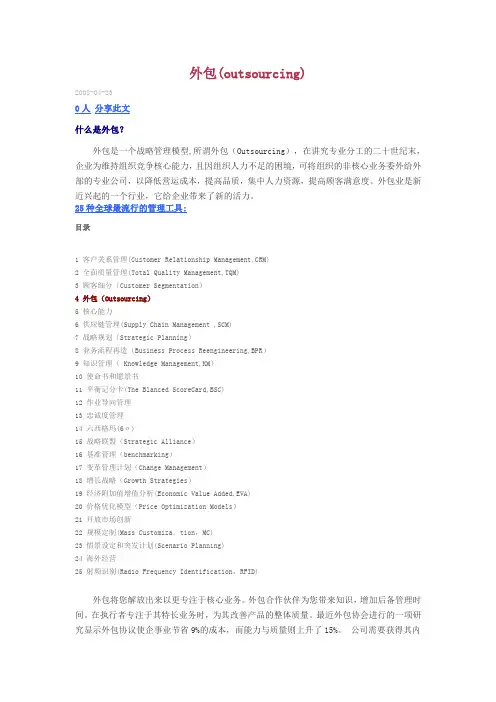
外包(outsourcing)2008-04-230人分享此文什么是外包?外包是一个战略管理模型,所谓外包(Outsourcing),在讲究专业分工的二十世纪末,企业为维持组织竞争核心能力,且因组织人力不足的困境,可将组织的非核心业务委外给外部的专业公司,以降低营运成本,提高品质,集中人力资源,提高顾客满意度。
外包业是新近兴起的一个行业,它给企业带来了新的活力。
25种全球最流行的管理工具:目录1 客户关系管理(Customer Relationship Management,CRM)2 全面质量管理(Total Quality Management,TQM)3 顾客细分(Customer Segmentation)4 外包(Outsourcing)5 核心能力6 供应链管理(Supply Chain Management ,SCM)7 战略规划(Strategic Planning)8 业务流程再造(Business Process Reengineering,BPR)9 知识管理( Knowledge Management,KM)10 使命书和愿景书11 平衡记分卡(The Blanced ScoreCard,BSC)12 作业导向管理13 忠诚度管理14 六西格玛(6σ)15 战略联盟(Strategic Alliance)16 基准管理(benchmarking)17 变革管理计划(Change Management)18 增长战略(Growth Strategies)19 经济附加值增值分析(Economic Value Added,EVA)20 价格优化模型(Price Optimization Models)21 开放市场创新22 规模定制(Mass Customiza.tion,MC)23 情景设定和突发计划(Scenario Planning)24 海外经营25 射频识别(Radio Frequency Identification,RFID)外包将您解放出来以更专注于核心业务。
一、英汉互译(每题2分,共30分)1. Apprenticeship:学徒2。
Career support:职业支持3。
Outsourcing:外包4。
Database:数据库5. Employee empowerment:员工授权6. Goals:目标7。
Human resource information system (HRIS):人力资源信息系统8。
Job rotation:岗位轮换9. Learning organization:学习性组织10. Psychological contract:心理契约11. 薪资调查:Salary survey12。
任务分析:Task analysis13. 招募:Recruit14。
绩效管理:Performance management15. 工作丰富化:job enrichment二、选词填空(每题2分,共20分)A.feedback B。
benchmarking C。
rewards D。
Human resource management E。
benefitF.on—the-jobG. performance H。
downsizing I。
Direct cost J。
output1。
refers to the practices and policies you need to carry out the people or personnel aspects of your management job。
2。
Labor turnover rates provide a valuable means of the effectiveness of HR policies and practices in organizations.3. Labor turnover can be costly。
of recruiting and training replacements should be considered.4。
委外计划英语Outsourcing is a game-changer in the modern business landscape, offering a wealth of opportunities to streamline operations, cut costs, and access a diverse pool of expertise. By entrusting tasks to external service providers, companies can sharpen their focus on core competencies while leavingthe rest to specialists. This strategic move not only boosts efficiency but also opens the door to innovation, as new perspectives can often lead to breakthrough ideas.The decision to outsource is not taken lightly; itinvolves a careful evaluation of the company's needs, the potential service provider's capabilities, and the long-term implications of such a partnership. When executed correctly, outsourcing can be a win-win situation, where both the company and the service provider can thrive. However, it requires clear communication, well-defined objectives, and a robust framework for managing the relationship.In the realm of English language services, outsourcinghas become particularly prevalent. Businesses areincreasingly recognizing the value of professional English language skills in areas such as content creation,translation, and localization. By outsourcing these tasks, companies can ensure that their message is conveyed with precision and cultural sensitivity, which is crucial in a global marketplace.Moreover, the rise of technology has made it easier than ever to collaborate with service providers from around the world. Platforms that facilitate communication, project management, and quality control are now standard, allowing for seamless integration of outsourced services into a company's workflow.In conclusion, outsourcing is a strategic decision that, when approached with diligence and foresight, can significantly enhance a company's competitive edge. It's about leveraging the strengths of others to achieve your own business goals, all while navigating the complexities of a dynamic and interconnected world.。
BPO面试专业知识1. 什么是BPO?BPO,即Business Process Outsourcing,是指企业将部分非核心业务流程外包给第三方服务提供商。
通过BPO,企业可以将后勤、非核心的业务流程外包出去,从而专注于核心业务的发展。
BPO通常涉及客户服务、财务和会计、人力资源、采购等方面的业务。
2. BPO的优势•降低成本:委托第三方承担一些业务流程可以大幅降低企业的运营成本,减少员工管理和培训的费用。
•提高效率:专业的BPO服务提供商通常拥有丰富的经验和高效的流程,可以更快速地完成任务并提高业务效率。
•专注核心业务:将非核心的业务外包出去,企业可以将更多的精力放在核心业务的发展上,提升企业的竞争力。
•共享风险:通过与BPO服务提供商合作,企业可以将一部分风险和责任转移到第三方身上,降低自身的风险承担。
3. BPO的应用领域BPO广泛应用于各个行业和领域,包括但不限于以下几个方面:3.1 客户服务客户服务是BPO应用最为广泛的领域之一。
企业可以将客户服务的部分流程外包给专业的客服外包公司,如呼叫中心公司。
这些公司通常拥有经验丰富的客服人员和先进的技术设备,能够提供高质量的客户服务,包括电话咨询、在线客服、客户投诉处理等。
3.2 财务和会计很多企业将财务和会计流程外包给专业的BPO服务提供商,以降低成本并提高效率。
这些BPO服务提供商通常会处理企业的账务、报表、税务申报等工作,确保企业的财务运作顺利进行。
3.3 人力资源企业的人力资源流程也是常常被外包的领域之一。
人力资源BPO服务提供商可以帮助企业进行招聘、培训、员工福利管理等工作,减轻企业的人力资源管理负担。
3.4 采购与供应链管理一些企业将采购和供应链管理的部分流程外包给专业的BPO服务提供商。
这些服务提供商通常可以提供更好的供应链解决方案和采购流程管理,以降低采购成本并提高供应链的效率。
4. BPO面试常见问题在参加BPO行业的面试时,以下问题是常见的:•你对BPO有什么了解?•你为什么想从事BPO行业?•你有哪些与BPO相关的专业技能?•你在过去的工作中如何处理客户投诉?•你如何保证在高压环境下工作的效率和质量?•你能否分享一次成功解决复杂问题的经验?•你对团队合作有什么看法?•你有没有在BPO行业面临过的挑战?你是如何应对的?•你对工作时间的灵活性有何看法?5. BPO行业的发展趋势随着科技的发展和全球化的进程,BPO行业也在不断演变。